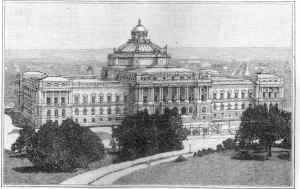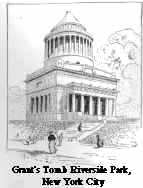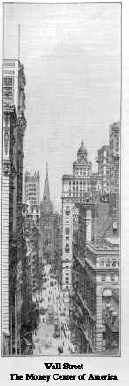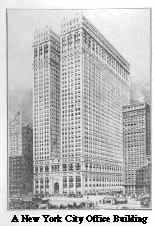Resource Center OLLibrary
|
368 |
|
[1897 |
|
by hundreds but by thousands of millions.1
We are sending abroad our tools, hardware, and machinery
in constantly greater quantities. American reapers,
mowers, sewing machines, watches, |
|
1898] |
|
369 |
|
|
|

CONGRESSIONAL LIBRARY BUILDING, WASHINGTON |
|
370 |
|
[1898- |
|
This change makes the good government of the United States depend very largely on the good government of our cities. If they are intelligently, honestly, and efficiently managed, all will probably go well; but if they are badly managed, all is likely to go wrong. The decision of this great question rests with those who are now voters, but it will soon rest with those who are to-day pupils in the public schools. In a few years you who are studying the history of your country will be called upon to take a hand in shaping its history. Your votes will then turn the scale, and America will be whatever you choose to make it. |
|
1898-] |
|
371 |
|
409. Revised State Constitutions
in the South and West; the Negro Vote shut out. Since
1890 seven southern states -- namely, |
|
372 |
|
[1898 |
years, but South Dakota was the first state here to make trial
of it. Later (1902), Oregon adopted an amendment to its
constitution similar to that of South Dakota. Since then a number
of other states have adopted like measures; so, too, have a number
of cities.
410. Spanish
Possessions in the Sixteenth Century. It will be remembered
that at the close of the sixteenth century Spaniards were the only
white men who had planted permanent colonies in North America
(§§ 29, 42). They, too, held the West Indies, the
greater part of South America, the Philippines, and other groups
of islands in the East. The King of Spain could then boast with
truth "that the sun never set on his dominions."
As late almost as the beginning of the
nineteenth century Spain still held the greater part of the West
Indies, Mexico, Florida, and the whole vast territory between the
Mississippi River and the Pacific, which is now part of the United
States.
In less than twenty-five years from that time
Spain had been forced to sell or had lost,1 all of her
immense possessions on the mainland of North America. The only
important islands she had left in the West Indies were Cuba and
Porto Rico.
411. The Revolution in Cuba; War for
Independence. Spain's oppressive treatment of Cuba caused
great discontent, and for many years there was danger of open
revolt. The southern slave states coveted the island, which is as
large as Pennsylvania and is almost in sight from Key West,
Florida. The United States (1845) offered Spain $100,000,000 for
Cuba, but met with a flat refusal. Later, several armed
expeditions tried to seize the island on behalf of the South. The
American ministers to Great Britain, France, and Spain met in
Belgium (1854), to discuss the Cuban question. They declared that
so long as Cuba should belong to Spain it would be dangerous to
our peace, and that if Spain should continue to refuse to sell us
the island we should be justified in taking it by
force.2
1 Napoleon forced
Spain to give up the great province of Louisiana to him; in 1803
he sold it to us (§ 215); Spain felt obliged to sell us
Florida, and at the same time (1819) to give up all claims to
Oregon (§ 238); and Mexico freed herself from Spain by
revolution.
2 Our ministers met in the city of
Ostend, and their declaration is known as the Ostend
Manifesto.
|
1898] |
|
373 |
Later (1868), a rebellion broke out in
Cuba1 which lasted ten years. Then (1895) a new
uprising occurred, and the Revolutionists declared themselves for
"independence or death."2 This revolt in Cuba excited
the people of the Spanish colony of the Philippines to declare
their independence.
President Cleveland said that if the war in Cuba
should go on, it must end in "the utter ruin of the island." He
took the ground that rather than see this, it would be our duty to
put a stop to the conflict. When President McKinley entered office
the Cuban war was still raging, and an enormous amount of American
property on the island had been destroyed.
On the one hand, the Revolutionists hanged those
farmers who would not take up arms and join them; on the other,
the commander of the Spanish army drove scores of thousands of the
people into the towns and shut them up there to die of pestilence
or starvation.
412. The Destruction of the Maine;
Report of the Court of Inquiry. While this horrible state of
things was going on, an event occurred which suddenly changed
everything. The United States had sent Captain Sigsbee in command
of the battle ship Maine to pay a friendly visit to Havana.
While lying in the harbor of that port the Maine was
destroyed by an explosion (1898). Two of her officers and the
greater part of her crew were killed. The terrible news acted like
an electric shock on the people of our country.
The United States appointed a naval Court of
Inquiry to make an investigation. The court reported that, in
their opinion, "the Maine was destroyed by the explosion of
a submarine mine," but they accused no one of having been guilty
of the act. The Spanish government expressed its regret at the
"lamentable incident"
1 The population of
Cuba consisted of (1) a small number of native Spaniards, who held
nearly every position of power and trust; (2) the other white
inhabitants, who constituted the great bulk of the people; (3)
mulattoes, free negroes, and Chinamen.
2 The progress of the rebellion
developed four parties: (1) the Revolutionists, who demanded
absolute separation from Spain; (2) those who asked for "home
rule" -- that is, the management of all local affairs -- without
separation from Spain; (3) the Spanish party in power, who opposed
any change whatever; (4) a very large number of Cuban farmers who
wished to remain neutral: all they asked was to be let alone and
allowed to cultivate their farms in peace; but neither the
Revolutionists nor the Spanish military authorities would permit
this.
 typewriters,
and firearms can be found for sale in every large city in
Europe.
typewriters,
and firearms can be found for sale in every large city in
Europe. Lack
of space in lower New York called for the erection of
enormously high business buildings, and the elevator made
them possible. Wall Street, Broad Street, and parts of
lower Broadway resemble canyons in the Rocky Mountains.
There are office buildings which rise to a height of from
600 to over 700 feet and contain from forty to fifty
stories. The bridges and tunnels of the city have been
mentioned (§ 382). In 1917 the city completed the
construction of the greatest water works in the world.
They bring an abundant supply of pure water from the
Catskill Mountains, more than a hundred miles
distant.
Lack
of space in lower New York called for the erection of
enormously high business buildings, and the elevator made
them possible. Wall Street, Broad Street, and parts of
lower Broadway resemble canyons in the Rocky Mountains.
There are office buildings which rise to a height of from
600 to over 700 feet and contain from forty to fifty
stories. The bridges and tunnels of the city have been
mentioned (§ 382). In 1917 the city completed the
construction of the greatest water works in the world.
They bring an abundant supply of pure water from the
Catskill Mountains, more than a hundred miles
distant. taken
(1790) (§ 202) we had only six cities which had 8000
or more inhabitants. Philadelphia came first with 42,000
and New York next with 33,000. By the census of 1900 the
total number of cities in the United States having 8000
or more inhabitants was 546. In 1790 only about three
persons in a hundred lived in cities, while in 1890
nearly thirty in a hundred lived in them; by the census
of 1910 the number had increased to forty-six in a
hundred; now the cities embrace almost half of our whole
population (see p. xl).
taken
(1790) (§ 202) we had only six cities which had 8000
or more inhabitants. Philadelphia came first with 42,000
and New York next with 33,000. By the census of 1900 the
total number of cities in the United States having 8000
or more inhabitants was 546. In 1790 only about three
persons in a hundred lived in cities, while in 1890
nearly thirty in a hundred lived in them; by the census
of 1910 the number had increased to forty-six in a
hundred; now the cities embrace almost half of our whole
population (see p. xl). Mississippi,
Louisiana, North Carolina, South Carolina, Alabama,
Virginia, and Georgia -- have adopted new or amended
constitutions. These states require every voter to be
able to read a section of the state constitution, or to
pay a certain amount of taxes, or both.
Mississippi,
Louisiana, North Carolina, South Carolina, Alabama,
Virginia, and Georgia -- have adopted new or amended
constitutions. These states require every voter to be
able to read a section of the state constitution, or to
pay a certain amount of taxes, or both.


